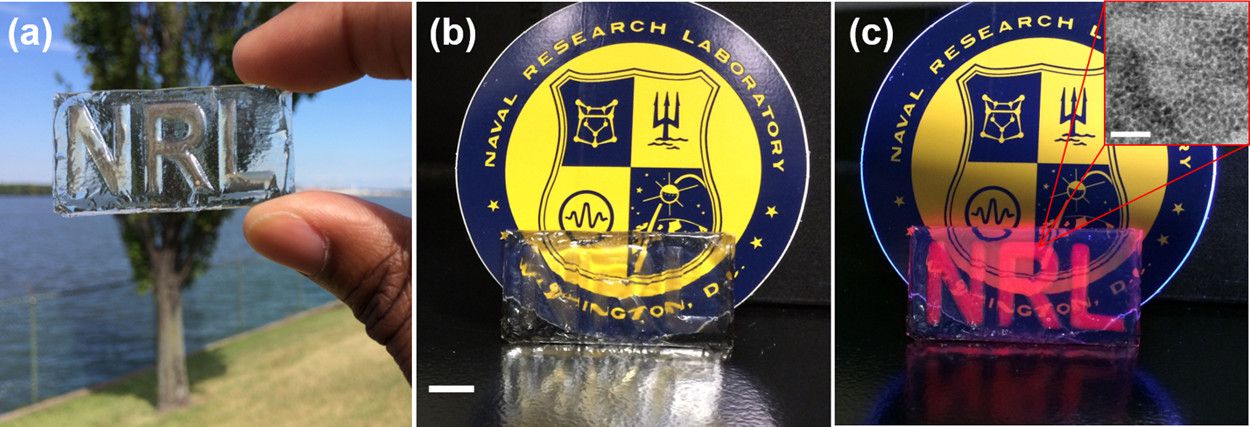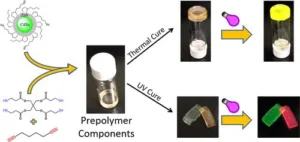A team of researchers at the Optical Sciences Division within the Materials Science and Technology Division at the Naval Research Laboratory (Washington, DC) and headed by Michael H. Stewart are developing a transparent, luminescent material The material is a thiol-yne nanocomposite polymer designed to hold light emitting Quantum Dots (QDs). Potential applications for the technology include displays that are flexible, stretchable and shatterproof.

A recent report by the team on this topic is entitled “Fabrication of Photoluminescent Quantum Dot Thiol-yne Nanocomposites via Thermal Curing or Photopolymerization.” The article was published during March, 2018 in ACS Omega, 2018, 3 (3), pp 3314-3320 A copy of the article is available for purchase here.
“Depending on the starting components, polymers fabricated using thiol-yne chemistry have been shown to be rubbery, stiff, high in refractive index, transparent and stable at high temperatures.” In addition, they are amenable to modification by the incorporation of nanoparticles to create polymer nanocomposites These desirable properties make thiol-yne polymers potential candidates for use in a wide variety of applications that are based on photoluminescent materials.
A specific goal of the current research was to showing that thiol-yne polymers fabricated via thiol-yne chemistry are a viable host matrix for QDs Such viability was to be demonstrated by the production of photoluminescent QD thiol-yne nanocomposites that did not suffer from QD aggregation or from quenching of the characteristic QD emissions within the nanocomposites.
In the present work, novel ligands were synthesized and used to functionalize QDs of various diameters (In chemistry, a ligand is an ion or molecule attached to a metal atom by coordinate bonding. Functionalization is the process of adding new functions, features, capabilities, or properties to a material by changing the surface chemistry of the material.)
All that was required to incorporate functionalized QDs into the thiol-yne prepolymers was the addition of the thiol-yne prepolymer to the QD solution This was done in a glass vial and followed by a just a few seconds of vigorous agitation. At this point, the prepolymer could be drop cast or spin coated onto a substrate or poured into a mold The material was then polymerized to form a QD thiol-yne nanocomposite polymer by exposure to ultraviolet light or by thermal curing. The figure below illustrates these two possible material fabrication processes.
Two possible QD thiol-yne nanocomposite fabrication processes.
When exposed to ultraviolet light, the transparent nanocomposites emitted light of the expected colors as determined by the diameters of the QDs This demonstrated that QDs could be incorporated into thiol-yne polymers without significantly altering the color of the light emitted by the QD. The researchers also determined that the QDs had a uniform distribution throughout the polymer matrix The figure below illustrates the emission properties of a sample polymer block containing QDs.
 Left and center: A molded thiol-yne polymer block containing red QDs in ambient conditions. Right: The polymer block when exposed to ultraviolet light. Inset images show the red QDs (1.5 ?m) within the matrix.
Left and center: A molded thiol-yne polymer block containing red QDs in ambient conditions. Right: The polymer block when exposed to ultraviolet light. Inset images show the red QDs (1.5 ?m) within the matrix.
In their article, the researchers conclude that their invention
“creates a material with tailorable optical properties, which are dependent on the monomers used in the prepolymer formulation and/or depending on the QDs incorporated into the prepolymer.”
They go on to explain that it should be possible to implement the method developed for the functionalization and incorporation of QDs into thiol-yne prepolymers and outlined in the report with other types of QDs and nanoparticles.
The U.S. Patent and Trademark Office recently published a patent application submitted by the Navy for the technology described in their article. It was assigned application number 16/153,357 In collaboration with the laboratory’s technology transfer office, TechLink, is charted to assist private businesses wishing to access the government funded research for commercial applications. -Arthur Berman

